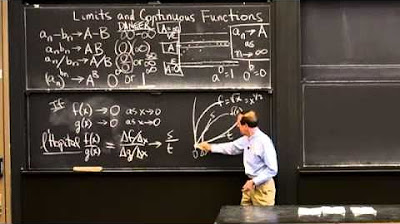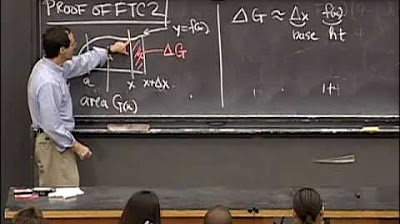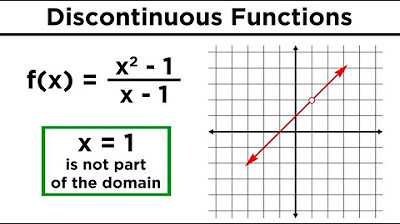Step Function and Delta Function
TLDRIn this video, Professor Gilbert Strang introduces two fundamental mathematical functions: the step function and the delta function. The step function, named after its inventor Heaviside, is a simple piecewise function that jumps from 0 to 1 at t=0. Its derivative, the delta function, is a theoretical construct that represents an infinite spike at a single point, t=0. Strang explains the practical applications of these functions in real-life scenarios, such as modeling an instantaneous input like a golf ball being hit. He emphasizes the importance of understanding their integral properties, particularly how the integral of the delta function over time equals 1, regardless of the time at which the impulse occurs. The video also demonstrates how to solve differential equations with these functions as inputs, highlighting the concept of impulse response, which is crucial in engineering. Strang concludes by noting the relevance of these functions in solving more complex problems, including those involving variable interest rates and non-linear equations.
Takeaways
- 📈 The step function, denoted as h(t), is a mathematical function that is 0 for t < 0 and 1 for t ≥ 0, representing a sudden change or 'step'.
- 🔄 The step function can be shifted along the t-axis by replacing t with t - T, causing the step to occur at t = T.
- 📉 The derivative of the step function results in the delta function, which is zero everywhere except at t = 0, where it has an 'infinite' value signifying a sudden change.
- 🌟 The delta function is often represented as δ(t) and is known for its property where its integral over the entire real line equals one, representing a total 'deposit' or impulse.
- ∫ The integral of the delta function times any other function f(t) from negative to positive infinity yields f(0), essentially the value of f at the instant of the impulse.
- 🛠️ The delta function is a key tool for modeling instantaneous inputs or events in differential equations, such as a sudden force applied to a system.
- 💡 The concept of the impulse response is introduced as the reaction of a system to an impulse, which is crucial in engineering and physics for analyzing system dynamics.
- 🧮 The step function is the integral of the delta function, and understanding their relationship is essential for solving differential equations with these inputs.
- 📚 The script emphasizes the utility of integration over differentiation when dealing with delta functions, as integration smooths out the mathematical expression.
- ⏱️ An example is given of a differential equation with a delta function input, which models a situation where a deposit is made at a single moment in time and then grows exponentially.
- 🔢 The generalization of the delta function to shifted delta functions, δ(t - T), is discussed, which shifts the impulse to occur at t = T rather than t = 0.
- 🔧 The script concludes with a teaser for future topics, including variable interest rates and non-linear equations, indicating the ongoing complexity and depth of the subject matter.
Q & A
What are the two functions introduced in the video?
-The two functions introduced in the video are the step function and its derivative, the delta function.
What is the step function denoted by?
-The step function is denoted by 'h(t)', named after its inventor, Heaviside.
What are the values of the step function h(t)?
-The step function h(t) has a value of 0 for t negative and a value of 1 for t greater or equal to 0.
How does shifting the step function horizontally affect its graph?
-Shifting the step function horizontally by a fixed number 'T' results in the jump of the step function occurring at 't equals T' instead of t equals 0.
What is the derivative of the step function?
-The derivative of the step function is the delta function, which is zero everywhere except at t=0, where it has an infinite slope.
What is the key property of the delta function that is used in calculus?
-The key property of the delta function used in calculus is its integral, which is the step function.
What is the total integral of the delta function over all time?
-The total integral of the delta function over all time (from negative infinity to positive infinity) is 1.
How does the delta function behave when multiplied by another function and integrated?
-When the delta function is multiplied by another function and integrated, the result is the value of that other function at the point where the delta function is non-zero (typically at t=0).
What is the solution to the differential equation dy/dt = ay + delta(t - T) with no initial deposit?
-The solution to the differential equation with a delta function input at time T is y(t) = 0 for t < T, and y(t) = e^(a(t-T)) for t >= T, representing a deposit of $1.00 that grows exponentially over time.
What is the concept of 'impulse response' in engineering?
-Impulse response is a fundamental concept in engineering that refers to the response of a system to a sudden input or impulse, which is represented by the delta function in mathematical terms.
Why are delta functions considered non-standard for calculus?
-Delta functions are considered non-standard for calculus because they do not have a defined value at the point of discontinuity (t=0), and their derivative is not well-defined, leading to an 'infinite' value which is not precise for standard calculus operations.
How does the interest rate affect the growth factor in the solution of the differential equation?
-The interest rate 'a' in the growth factor e^(a(t-T)) affects the exponential growth of the deposited amount over time. A higher interest rate results in a faster growth of the deposited amount.
Outlines
📈 Introduction to Step and Delta Functions
The video introduces two mathematical functions: the step function and its derivative, the delta function. The step function, named after its inventor Heaviside, is defined as 0 for negative time and 1 for time greater or equal to zero. It is characterized by a jump or discontinuity. The video also discusses the concept of shifting the step function and its derivative, the delta function, which is zero everywhere except at a specific point where it has an infinite slope. The delta function is significant in modeling instantaneous changes, such as the impact of a golf club hitting a ball.
🧮 Calculus with Step and Delta Functions
The video explains the use of step and delta functions in calculus, emphasizing that while the delta function's derivative is problematic, its integral properties are well-defined and useful. The step function is the integral of the delta function, and the key property of the delta function is that its total integral over all time is 1. The video also explores the concept of integrating the delta function with other functions, showing that the integral is simply the value of the other function at the point where the delta function acts.
🔢 Using Delta Functions in Differential Equations
The video demonstrates how to use delta functions as source terms in differential equations. It shows that the delta function can model an instantaneous input, such as a deposit of $1.00 at a specific time, which then grows exponentially over time. The solution to the differential equation with a delta function input is derived, illustrating how the system responds to an impulse. The concept of impulse response is highlighted as crucial in engineering, particularly for second-order differential equations.
🔄 Future Topics: Variable Interest Rates and Non-linear Equations
The video concludes with a teaser for future topics, which will include allowing the interest rate to change and exploring non-linear equations. The delta function is introduced as a fundamental concept that will reappear in subsequent discussions, emphasizing its importance in mathematical modeling and engineering applications.
Mindmap
Keywords
💡Step Function
💡Delta Function
💡Derivative
💡Integration
💡Shifted Step Function
💡Impulse Response
💡Differential Equation
💡Heaviside Function
💡Unit Delta Function
💡Generalized Function
💡Linearity
Highlights
Introduction to two important mathematical functions: the step function and its derivative, the delta function.
The step function, denoted as h(t), is defined as 0 for t < 0 and 1 for t >= 0.
The step function can be shifted by replacing t with t - T, causing the jump to occur at t = T.
The derivative of the step function results in the delta function, which is zero everywhere except at t = 0 where it has an infinite slope.
The delta function is not a well-defined function at the point of the jump, but it is useful for modeling instantaneous inputs.
The integral of the delta function is the step function, with the integral from negative to positive infinity equalling 1.
The key property of the delta function is knowing its integral, which represents the total input from the source term.
The integral of the delta function times any other function f(t) is simply f(0), capturing the value of f at the moment of the impulse.
The delta function can be generalized to a shifted delta function e^(t)δ(t - T), with the integral capturing the value of e^(T) at the moment t = T.
Using the delta function as a source term in a differential equation allows solving for the response to an instantaneous input at time T.
The solution for a delta function input shows an initial response of 0 up to time T, followed by exponential growth e^(a(t - T)) for t > T.
The concept of impulse response, or the system's response to an impulse input like the delta function, is crucial in engineering.
The step function serves as the integral of the delta function, illustrating the relationship between these two functions.
Integration is a powerful tool for working with the delta function, smoothing out the discontinuities and focusing on the overall behavior.
The delta function allows modeling of instantaneous events, such as a golf club hitting a ball, as occurring in zero time.
The delta function is a generalized function, not a legitimate function, but it is extremely useful for certain calculations in calculus and engineering.
The total integral of the delta function from negative to positive infinity is 1, representing the total deposit made at a single moment.
The delta function can model a variety of inputs, from a continuous input over time to a single deposit at a specific moment.
Transcripts
Browse More Related Video

Limits and Continuous Functions

Lec 20 | MIT 18.01 Single Variable Calculus, Fall 2007

Ch 5: What are Dirac deltas and wavefunction inner products? | Maths of Quantum Mechanics

Continuous, Discontinuous, and Piecewise Functions

Business Calculus - Math 1329 - Section 1.1 - Functions

The Stability and Instability of Steady States
5.0 / 5 (0 votes)
Thanks for rating: